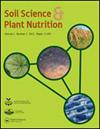Estimation of P retention capacity by the water content of soil kept with a saturated NaCl solution in a desiccator
IF 1.8
4区 农林科学
Q3 ENVIRONMENTAL SCIENCES
引用次数: 0
Abstract
ABSTRACT Phosphorus (P) retention capacity is an important soil parameter for site-specific nutrient management in croplands as well as a diagnostic criterion for classifying Andic properties. Air-dried soil water content is positively correlated with P retention capacity and has been proposed as a simple P retention capacity index; however, air humidity can affect the water content of air-dried soils. Therefore, in the present study, we 1) tested whether the water content of air-dried soils can be stabilized when they are kept with a saturated sodium chloride (NaCl) solution in a closed desiccator and 2) developed a model for predicting P retention capacity across various soil types. We tested 306 soil samples from paddy rice fields in Madagascar, exhibiting P retention capacities of 10.1–96.1%. Placing a saturated NaCl solution with the soil samples in a closed desiccator for one week kept the relative humidity inside the desiccator at 57–66%, regardless of the temperature and relative humidity outside the desiccator. The accuracy of the model predicting P retention capacity by soil water content was higher when soils were kept with the saturated NaCl solution [R2 = 0.870; root mean square error (RMSE) = 8.30] than without the solution (R2 = 0.812; RMSE = 9.96) at room temperature. The high correlation between P retention capacity and soil water content was mainly attributed to Al oxides. Additionally, the reproducibility of soil water content was enhanced by this method under different relative humidity conditions. However, compared with room temperature, controlling the temperature at 15°C and 30°C did not further improve the accuracy of the model when the soils were kept in the desiccator with saturated NaCl solution, although soil water content was higher at 30°C than at 15°C and room temperature. Therefore, we conclude that soil P retention capacity can be simply and accurately estimated with high reproducibility according to the water content of soils kept with saturated NaCl solution in a closed desiccator for one week at a room temperature.用饱和NaCl溶液在干燥器中保持的土壤含水量估算保磷能力
本文章由计算机程序翻译,如有差异,请以英文原文为准。
求助全文
约1分钟内获得全文
求助全文
来源期刊

Soil Science and Plant Nutrition
农林科学-农艺学
CiteScore
4.80
自引率
15.00%
发文量
56
审稿时长
18-36 weeks
期刊介绍:
Soil Science and Plant Nutrition is the official English journal of the Japanese Society of Soil Science and Plant Nutrition (JSSSPN), and publishes original research and reviews in soil physics, chemistry and mineralogy; soil biology; plant nutrition; soil genesis, classification and survey; soil fertility; fertilizers and soil amendments; environment; socio cultural soil science. The Journal publishes full length papers, short papers, and reviews.
 求助内容:
求助内容: 应助结果提醒方式:
应助结果提醒方式:


